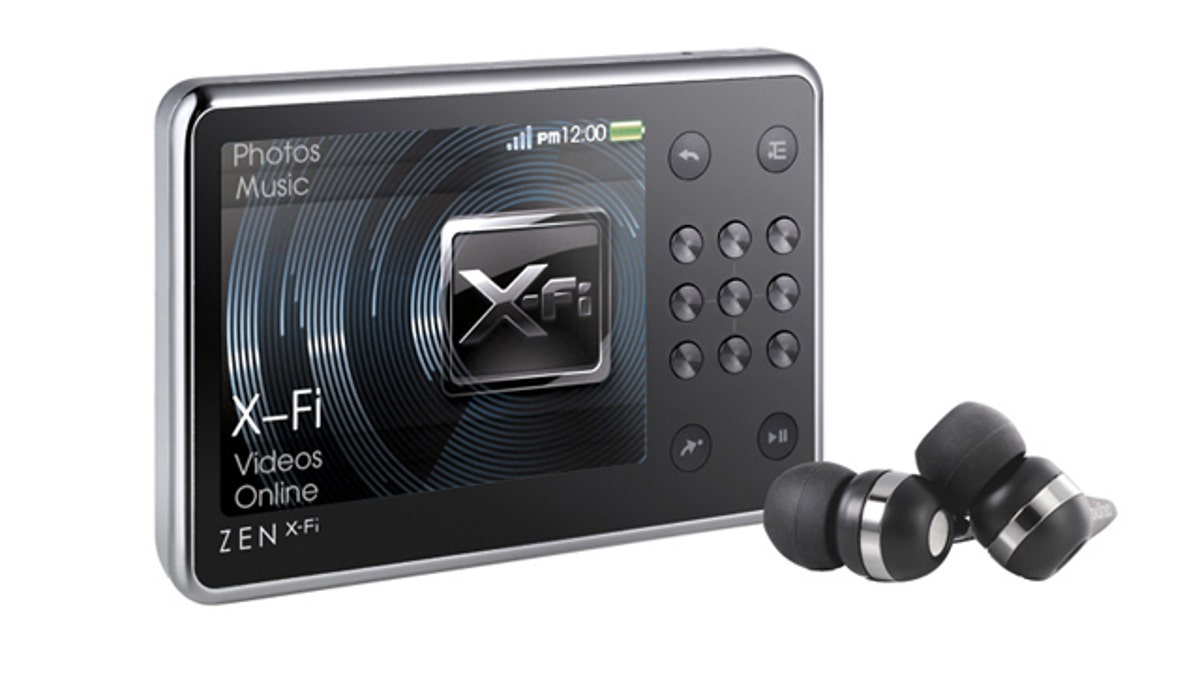
"Flash memory" players store music not on spinning platters but in memory chips. You'll find capacities up to 32GB, like in this Creative Zen X-Fi 32GB model (Creative Labs)
When they said "you can't take it with you," they certainly weren't talking about music. Sony's game-changing Walkman was a landmark in consumer electronics, but it was the Apple iPod that made addiction to earbuds a worldwide phenomenon.
This holiday season, you have many more choices than just the iPod. (Even the iPod has four different choices, and that's before you pick a color.) You can find some smaller devices with limited features for $20 or less, or you can spend $500 or more for a full-blown model that rivals a portable computer in complexity.
It's not even fair to call them "MP3" players any more, since many will also let you watch movies and videos as well. So what do you need to know to buy the perfect holiday gift?
Video or Music Only: The best place to start is to make a choice: Do you want to watch movies on the thing? If all you want is to play music, that narrows the field (and may save you a bunch of money). To watch video, you need a full-color screen big enough to watch. That adds to the product's cost; a music-only device can get by with a simple text display, or maybe even no display at all.
FM Radio: No matter how great your music collection may be, it's possible that you'll get tired of it at times. Or maybe there's a sporting event or interesting news event that you want to follow. At times like these, you'll appreciate a media player that includes an FM tuner. Even some inexpensive models like the Sansa Clip+ 2GB model have this handy feature.
Storage Matters: The music (and video) you listen to gets stored in the media player, so one of the most important features is storage capacity. And physical size has little to do with capacity; you can fit an entire CD collection on a device smaller than a pocket watch. As a rule of thumb, you can store between 250 and 500 songs per gigabyte (GB) of storage. So a 2GB media player should hold 500 to 1,000 songs. At about 3 minutes per song, that's between five and 10 hours of listening pleasure.
You'll find two different types of storage in media players. Some use a hard disk drive, just like a computer. These can have enormous capacities, like the 160GB iPod Classic, but they tend to suck down power faster.
The alternative is "flash memory," meaning storage based not on spinning platters but memory chips. You'll find capacities up to 32GB, like in the Creative Zen X-Fi 32GB model. In most cases, some or all of the flash memory is permanently installed in the device. Many also offer the ability to read memory cards, which makes it easy to swap out different collections and copy files from a computer.
The SD card is the same format used by most digital cameras, so it may be most convenient to get one that uses these same type of cards. Media players that use flash memory tend to be smaller, lighter, and last longer on a battery charge then models equipped with hard drives.
Can You Hear Me Now? You might be surprised to learn that not all media players can play all music files. The most common is the MP3 format, and just about every media player can handle this format. However, the Apples iTunes service provides files in a format known as AAC, and this may include copy protection which can prevent you from playing the files on different devices.
Other formats exist, such as WMA (a Windows Media Player format) and OGG (an open-source format), and some players tout their ability to play these files. But you probably only need MP3 support.
Screen Issues: When it comes to looking at photos or watching videos on a media player, you need to consider two details: size and resolution. First, the screen needs to be big enough to see the picture on it; a 2-inch diagonal is the minimum, but bigger is better, especially if you're going to watch widescreen movies.
But a bigger screen doesn't mean a higher resolution screen. You won't find any high definition media players, although some have very low resolutions such as 320 by 240. More pixels (dots) are better, and on some larger models you'll find a more detailed 800 by 480 resolution — like on the 4.8" screen of the Archos-5. Some devices, like the Sony Walkman NWZ-X1051F, have an OLED screen that will look sharper and brighter than an equivalent LCD screen.
The very newest media players have touch screen interfaces that are much cooler to use than the plain old buttons and jog wheels found on earlier models. Just expect to pay a big premium for this feature.
Other Features: Media players come with a variety of other functions that can be handy if you need them — but they're just embellishments if you don't. Some to look for are voice recording (a handy way to take notes and reminders), GPS navigation, and even built-in video cameras.
Some media players are can connect to the Internet or your home network using a wireless Wi-Fi connection, which can make it easy to browse the Web or transfer music files from your computer. Some also have Bluetooth connections that let you hook up to your computer or headset without wires.
But all of them play great music and fit in your pocket. And that's really the point, isn't it?




















